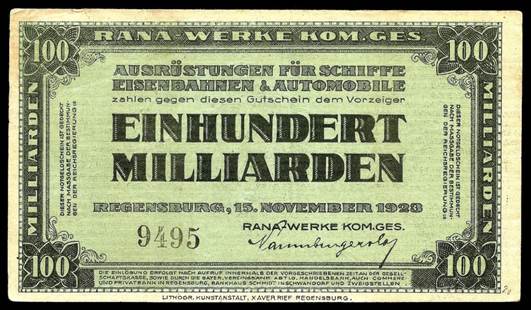USA - $20 1914
Transportation Vignette:
Vehicles Identified
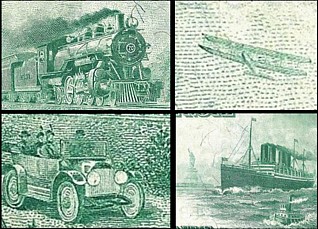
One of the most popular collectible currencies from the United States is the large sized banknotes from 1914. These banknotes are popular in large part because they are still readily available at a (mostly) affordable price, and they offer an older glimpse into a time past in the early 20th century, with beautiful vignettes on the reverse. One of these is the 20 dollar bill issued in 1914 that shows a wonderful Transportation theme, with a locomotive, airplane, ocean liner, and automobile.


According to the book The Engravers Line by Gene Hessler, the engraver of this reverse of the 1914 $20 was Marcus W. Baldwin. The book lists the engraving title simply as “Land, Sea and Air” with no designation of the types of train, car, airplane, and name of the ship given. No other information on the engraving was found in The Engravers Line.
This is not surprising, as the government takes a position of being purposefully vague in these depictions, so as to not be accused of endorsing any particular company, persons, brands, etc. The B.E.P. states on their website that legal requirements do not allow any government agency to portray a commercial firm or product, the engravings are types of hybrids that are not specific to any one type. For example, the US $10 dollar bill has a vehicle on it that is a hybrid of the popular types at the time of the engraving. Was this also the intention during the time of the engraving of the vignette on the 1914 note? I could find no reference on the site concerning the laws at that time. But in this particular case, it is perhaps a little easier to figure out where they drew their inspiration from, leading to some interesting discoveries.

Part 1: The Ship
The first point of interest was to find the name of the ship, as it was without a detectible name on the bow. Surprisingly, I found that only 15 four-funnel ships were built. Of those, only two also had three masts: fore, amidships, and aft: the SS Kaiser Wilhelm II, and the SS Kronprinzessin Cecilie. There was never an American made 4-funnel ocean liner!

Of particular interest was that both ships were seized by the United States when it entered WWI, with the SS Kaiser Wilhelm II being renamed the USS Agamemnon #3001, and the SS Kronprinzessin Cecilie being renamed the USS Mount Vernon #4508.
The SS Kronprinzessin Cecilie was detained in US Waters and brought to port after the outbreak of WWI, and was officially seized by the US Government on February 03, 1917. The SS Kaiser Wilhelm II was detained August 06 1914 upon entering US Waters, and was officially seized in August 1917. The banknote, however, was issued in 1914, and the engraving must have been decided upon sometime before that.





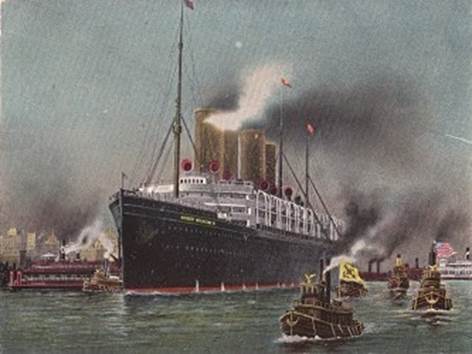
I was later contacted by a collector of Citrus Fruit Labels, who had also done some research on a label that had a picture of the same ship, Kaiser Wilhelm II. In fact, the ship from the citrus label appears to be a little more similar to the one used in the banknote, especially when you consider how the waves and smoke from the stacks are depicted.

Compare the images from the two postcards and the citrus label to the image of the US $20 dollar banknote, and you can readily see the significant similarities between them. It is evident that these ships, if not identical, were at least close enough to be easily confused with each other. Whichever ship it was, I believe that both this postcard image as well as the citrus label, both printed well before the banknote was printed, must have been the inspiration for the ship depicted on the 1914 US $20. It had to be both. The banknote image is clearly made up using rougher waves as shown on the citrus label picture and the tug boats from the postcard. combined, they pretty much show an almost identical picture of the ship vignette.
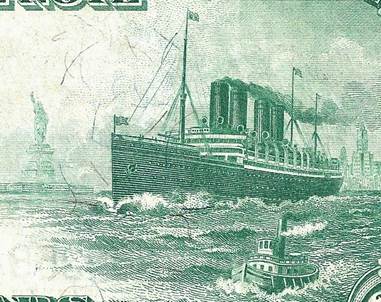
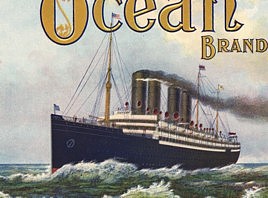


Upon close examination of the color postcard showing the SS Kaiser Wilhelm II in New York Harbor, the image reveals a little more information on the different flags that the ship is flying from her various masts:
- The flag on the bow of the ship is indistinguishable.
- The flag on the forward mast is definitely the United States flag.
- The flag on the center mast is indistinguishable.
The flag on the aft mast is hard to tell, but I think it is the red and white flag “Hotel” meaning that the ship has a pilot on board – which would make sense, being in port.
Being a larger image overall, the flags on the Citrus Label were more easily seen, but are different from the postcards:
- The flag on the bow of the ship is blue, but there is no meaning to this flag.
- The flag on the forward mast is definitely the United States flag.
- The flag on the center mast is horizontal stripes of red/blue/red – but no meaning.
- The flag on the aft mast is vertical stripes yellow/white/yellow, with an apparent emblem in the center. There is no nautical or national flag of this type.
Despite the differences in the flags on the postcards and citrus label, they are still largely meaningless asides from the flag of the United States.
So – What is a German ship in New York Harbor doing flying an American flag? Well, keep in mind that in this image, we cannot see the stern of the ship. This is where the ships national flag would have been flown, as it is the place of honor on a ship. However, when a ship is in a foreign port, it is customary to fly the host nation’s flag from one of the masts. This simple gesture is what may have misled the B.E.P. personnel in thinking that it is an American ship.
If this postcard image truly was the inspiration for the ship on the 1914 $20, the question as to whether the engraver (and others in the BEP) thought that this was a US ship and placed it in the vignette could be explained by seeing the US flag flying, and not knowing that this is a simple courtesy, and not the country of origin.
In searching for a similar type of vehicle for the train, plane and car on this vignette, I feel that, even given the subtleties and vagueness of the depictions, there are enough details to ascertain their make and models and we are able to make more than a general guess.

Part 2: The Plane
Aviation was still new in 1914, and the number of aircraft in the sky were limited in numbers. The depiction on the reverse of the 1914 $20 bill lends some important clues, however. Given the design of the plane, I think is a type of flying boat. The fuselage is below the wings and is similar to that style of the time. Also, the plane is a biplane, with both the top and bottom wings of equal, or nearly equal, length. The Curtiss Flying Boat of the era had a much shorter bottom wing, and was ruled out. But the Benoist XIV was a great match. Further, the Benoist seaplane was the first aircraft in the world to provide regular passenger service. On New Year’s Day in 1914, Pilot Tony Janus flew the first two passengers from St. Petersburg, Florida to Tampa, Florida – a distance of 30 miles, in only 20 minutes!
The company was called the St. Petersburg-Tampa Airboat Line and offered two flights a day for $5.00 a person, including luggage! An overweight charge for persons over 200 pounds was in effect, though.


Part 3: The Train
The train is what’s known as a 4-6-2 steam engine. The 4 refers to the four small wheels in the front, the 6 refers to the 6 large wheels in the middle and the 2 refer to the 2 smaller wheels close to the engineer’s compartment. Many types and styles of steam engines were in use at that time, and many 4-6-2 engines were employed as passenger train haulers. I believe that the train in the vignette is subjected somewhat more to artistic license than the other vehicles on this banknote, as it comes close, but I simply could not find an exact match.


Part 4: The Automobile
The car is very similar to the 1912 Chevrolet little Six model. So close in fact, that there is no doubt that this was the vehicle used as the model for the vignette. There are only two differences between the drawing and the actual Light Six: The windshield supports and the front fender sweep to the running boards. Yet, in some advertisements and photos, the windshield supports are in place when the top portion of the windshield is up. This is an artistic variance that is understandable.





To make things even more fun, there was a company in Regensburg, Germany that issued a type of emergency money called ‘Notgeld’ in 1923. Notgeld was issued by companies and governments after WWI when inflation was rampant throughout Europe. This company was called ‘Rana-Werke’ and supplied items for the automotive, railway and shipbuilding industries. The reverse of their note is very similar to, if not an outright copy of, the US $20.00 bill issued in 1914.
